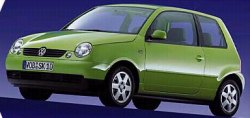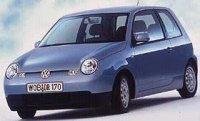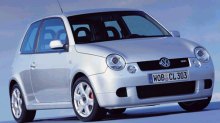 There's
no secret that Volkswagen Lupo is a retrimmed Seat Arosa, but it
doesn't
mean the VW is manufactured in Spain. In fact, both the Arosa and the
Lupo
are produced in VW's headquarters, Wolfsburg of Germany. There's
no secret that Volkswagen Lupo is a retrimmed Seat Arosa, but it
doesn't
mean the VW is manufactured in Spain. In fact, both the Arosa and the
Lupo
are produced in VW's headquarters, Wolfsburg of Germany.
What separates them apart is the trimming - the Seat is always bread and butter while the supposed-to-be-superior Volkswagen gains higher level of packaging. For instance, the interior side of the doors is trimmed with textile material of the same colour as the car body. The facia is designed to be more stylish and is also built with better material, although quite hardly matching the Golf. Twin-dial dashboard injects sporty image. Outside, the Lupo gets a pair of circular headlamps thus make it looks smarter. They are based on the Polo platform, with wheelbase and rear overhang shortened. As a result, rear passenger's leg room and the boot volume are sacrificed. The purpose is clear : Polo is designed for family men or women, Lupo is for unmarried young people who rarely travel with rear seat passengers. Lupo is a safe but boring car to handle. If understeers most of the time, rolls more than keen drivers would expect. Steering lack of sharp response than Ford Ka and Fiat Seicento Sporting. Nevertheless, it rides fine and has a healthy range of engines - bottom of the range is the familiar 50hp 1.0-litre from Polo. Next up is a new 16-valve 1.4 capable of 75hp (up 15hp from the previous 8-valver). This isn't really sporty but keeping it below 5,000rpm (where it maximum power generates at this suprisingly low rev) and it provides useful torque and good refinement. Above 5,000rpm, it because noisy and harsh. The range topping
GTi is
powered by the 100hp 1.4 dohc 16V, also comes from Polo. In contrast to
the sohc version, it is too peaky indeed. |
| The above report was last updated in 1998. All Rights Reserved. |
 Lupo
1.2 TDi is the first so-called "3-litre car" in the world - consumes
just
3 litres of fuel to run 100km. How does it achieve this ?
Lupo
1.2 TDi is the first so-called "3-litre car" in the world - consumes
just
3 litres of fuel to run 100km. How does it achieve this ?

 This
is Volkswagen’s best attempt for years to revive the spirit of the
original
Golf GTI. What made the Golf Mk1 classics is lightweight, quick and fun
to drive - sadly, 2 of these elements no longer exist in the current
line-up.
To make a new GTI light, the company decided that it should be based on
the smallest car, Lupo, and then replaced the steel bonnet, doors and
front
fenders with aluminium ones. It is probably not as expensive as you
thought
because the former 2 comes from the 3-litre Lupo. As a result, the car
weighs an official 978 kg or 960 kg according to Autocar’s scale. This
compares favourably with Peugeot 206 GTI (1028 kg) and ties with the
long-serving
106 GTI (961 kg).
This
is Volkswagen’s best attempt for years to revive the spirit of the
original
Golf GTI. What made the Golf Mk1 classics is lightweight, quick and fun
to drive - sadly, 2 of these elements no longer exist in the current
line-up.
To make a new GTI light, the company decided that it should be based on
the smallest car, Lupo, and then replaced the steel bonnet, doors and
front
fenders with aluminium ones. It is probably not as expensive as you
thought
because the former 2 comes from the 3-litre Lupo. As a result, the car
weighs an official 978 kg or 960 kg according to Autocar’s scale. This
compares favourably with Peugeot 206 GTI (1028 kg) and ties with the
long-serving
106 GTI (961 kg).